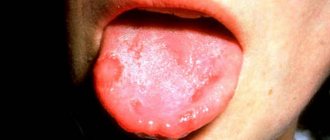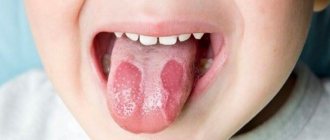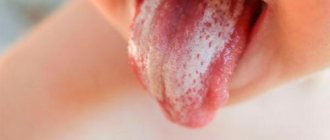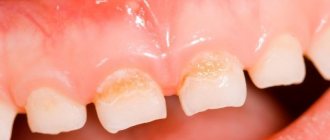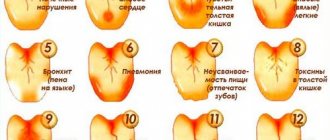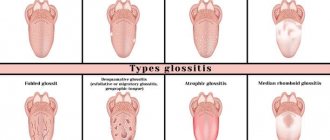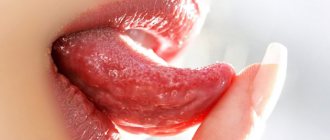Every caring mother can share her experience of worrying about children’s illnesses, especially if it concerns infants.
There is definitely no need to panic when identifying signs of disease; precious time is wasted. What to do if ulcers are detected on the tongue and which specialist to contact will be discussed in the article.
Children's tongue diseases: what to do if painful ulcers appear in your baby's mouth
Among all the organs of the human body, the tongue is given special importance. It is with its help that we can distinguish the tastes of our favorite dishes, determine the consistency and temperature of products. In addition, the organ takes a direct part in verbal communication. Therefore, when suspicious tumors, inflamed areas and plaque appear on it, a person begins to experience severe discomfort and inconvenience. Anxious parents especially have a lot of fears and worries about this when signs of the disease are observed in young children. Today we will talk about what tongue diseases can appear in a child and what ulcers on the body of the organ usually indicate.
What are the types of tongue diseases in childhood?
Tongue diseases common among children
The appearance of a dense, indelible plaque, the occurrence of pain in the organ and the formation of ulcers on it do not always indicate a disease of the tongue - it may be due to pathological processes in the internal systems of the body, an allergic reaction, or, for example, severe trauma to the mucous membrane. As for the most common diseases of the main speaking organ among children, experts in the field of pediatric dentistry identify the following pathologies:
- glossitis: the most commonly diagnosed disease of the tongue, which is inflammatory in nature. Pathology can be triggered by external factors, for example, injury or burn, or pathological processes within the body - the spread of infection and the consequences of past illnesses,
- Desquamative glossitis (geographical tongue): a separate type of glossitis that may be congenital. Uneven red spots appear on the surface of the organ, surrounded by a whitish edging, resulting in the formation of a pattern reminiscent of a geographical map - hence the name,
The pattern on the tongue resembles a map - candidal stomatitis (thrush): the spread of a fungal infection, accompanied by the formation of a dense white plaque with a cheesy consistency. Infants and children under 10 years of age are at increased risk,
Stomatitis is common in infants - leukoplakia: inflammation of the mucous membrane, which leads to keratinization of one or several areas of the tongue. In children, the so-called mild form of the disease is more often diagnosed, although cases of the development of flat and erosive leukoplakia are often encountered. Typically, the disease “attacks” children aged 5 years and older, and, as a rule, becomes a consequence of constant mechanical injury to the soft tissues of the oral cavity,
- herpes: an infectious disease caused by the herpes simplex virus, accompanied by the formation of small watery blisters on the surface of the mucous membrane, which burst after a while, after which they take a long time to heal, causing serious discomfort and pain.
The above describes the pathologies that are most common in childhood. In fact, there are a huge number of diseases that lead to deformation of the tongue, the appearance of tumors on it and the development of severe pain. To identify the true causes of suspicious symptoms, you cannot do without the help of a qualified expert.
Causes
Causes of tongue ulcers in children:
- Stomatitis (aphthous, herpetic, necrotic);
- Thrush;
- Thermal burn, injury;
- Afta Bednar;
- Diseases of internal organs;
- Rashes caused by taking medications;
- Reduced immunity.
The type of rashes and methods of their treatment depend on the disease that caused them.
Reds
Red ulcers on a child’s tongue indicate an inflammatory process in the oral cavity.
Red ulcers occur in diseases such as:
- Stomatitis;
- Glossitis;
- Bacterial dermatosis;
- Herpetic infection.
The appearance of ulcerative wounds on the tongue can be caused by an allergic reaction of the body to foods or fruits and vegetables that are red or orange in color. Sometimes it is worth analyzing the child’s diet so that there is no unnecessary cause for concern.
Infectious diseases in which red sores appear are accompanied by pain and increased salivation. The child is capricious and refuses to eat and drink. Body temperature rises. Treatment is carried out with the use of antiseptics, which are used to treat the surface of the tongue.
White
White ulcers on the tongue or a whitish coating may appear with non-infectious glossitis. The disease is associated with hormonal imbalance, worms, and disturbances in the gastrointestinal tract. With glossitis, the ulcers can change locations, but do not cause discomfort.
How to treat ulcers in this case? Sometimes it is enough to enrich the baby’s diet with vitamin complexes or treat the affected areas with antiseptic agents.
In newborns and children under one year old, white sores occur due to thrush. The disease is caused by low immunity or taking antibacterial drugs.
Ulcers appear randomly. At the tip of the tongue, later found in the larynx area. They are not painful and are covered with a coating reminiscent of curd masses.
If rashes on a child’s tongue are accompanied by pain, anxiety, and high fever, fungal diseases can be suspected. To get rid of thrush, it is enough to treat the surface of the tongue with a weak soda solution. In other cases, more serious antifungal treatment is required.
Purulent
Purulent ulcers on the tongue appear with stomatitis. First on the tip of the tongue, gradually spreading over the entire surface of the mucous membrane, capturing the inner surface of the cheeks. Plaques are painful, purulent, white with a red edge.
Stomatitis can be suspected if there is an unpleasant odor from the mouth that smells of acid.
The main reason is most often associated with failure to comply with basic hygiene standards. This explains why the pathology occurs in older children.
In addition to regular oral hygiene, it is necessary to treat purulent rashes with antiseptics. This is an elementary practice that allows you to get rid of the disease and is used as a preventive measure.
The same symptoms may appear after a thermal burn or against the background of an allergic reaction. The curiosity of children in the first years of life leads to dangerous objects, powders or liquids appearing in the mouth.
On the tip
Small single ulcers on the tip of the tongue most often occur due to trauma. The baby can damage the tip by biting it. It is possible that the injury was caused by sharp cutlery. Such ulcers on a child’s tongue do not require special treatment. It is enough to carry out hygiene procedures, avoid hot foods and drinks until complete healing.
An ulcer on the tip of the tongue, especially an old one, may indicate an infectious disease. Small ulcers on the tip of the tongue appear with the following diseases:
- Stomatitis;
- Glossitis;
- Liver or gastrointestinal diseases.
Even if this does not cause any discomfort to the baby, it is necessary to see a pediatrician and undergo an examination.
Side
A lack of vitamins B6 and B2 in a child’s body can cause ulcers to appear on the side of the tongue and at the same time on the lips or in the corners of the mouth. If the whites of the baby's eyes turn red and dandruff appears, this confirms vitamin deficiency. Ensuring a complete supply of B vitamins is quite difficult. This requires complex vitamin therapy.
Signs of a pathological condition
With the development of any pathological processes in the oral cavity, small children, like adults, experience certain inconveniences and sometimes quite severe pain. Against the background of the appearance of such symptoms, there is a sharp deterioration in the general state of health, a loss of strength is observed, in some cases there is an increase in body temperature and loss of appetite, the baby will refuse breast milk or the offered formula.
The child may feel pain, burning and tingling in the tissues of the organ. As for visual manifestations, most often they take the form of a thick, indelible coating, which can range in color from white to gray or even black, as well as spots, blisters and painful ulcers, which we will talk about in more detail later.
Causes of ulcers on the organ body
Small ulcers on a child’s tongue can be the result of both mechanical injuries and infection entering the body. Experts in this regard identify several main and most common reasons for the appearance of such formations on the mucous membrane:
- diseases of the oral cavity and tongue in particular,
- pathological processes of internal organs and systems,
- poor oral hygiene,
- weakened immunity,
- allergic reaction,
- mechanical, thermal and chemical effects,
- deficiency of vitamins and beneficial microelements.
When a child experiences an acute lack of vitamins for a long time, certain disruptions occur in the overall balance. It’s not for nothing that the tongue is called an indicator of human health - its appearance can tell a lot about the state of the whole organism as a whole.
Treatment methods
The tactics for treating ulcers on a child’s tongue depends on the type of disease and its course.
Aphthous stomatitis
The most common disease is aphthous stomatitis.
The following reasons can provoke its development:
- Sometimes the aphthous form of stomatitis in a child is often confused with the herpes virus
stress;
- genetic factor;
- lack of vitamins;
- allergy;
- folic acid deficiency.
Sometimes the aphthous form of stomatitis in a child is often confused with the herpes virus.
Mistakes can be avoided by carefully monitoring the development of the disease.
With stomatitis, at the initial stage, red dots form, after which white and gray bubbles with a red rim form in their place. Ulcers appear after the blisters burst.
To treat aphthous stomatitis, an integrated approach is used, including:
- systematic procedures for rinsing the mouth with decoctions of medicinal plants (calendula, chamomile, tea tree, etc.) and solutions of potassium permanganate, lugol;
- local treatment of affected areas of the mucous membrane with pharmacological agents (for example, methyluracil ointment).
The duration of treatment depends on the severity of the disease and the regularity of the procedures.
Herpetic stomatitis
Drug treatment is prescribed by a doctor, taking into account the characteristics of the body and the degree of neglect of the disease.
Treatment of the disease in its advanced form is carried out in a pediatric hospital or infectious diseases department.
Mild cases of herpetic stomatitis are carried out on an outpatient basis, but the child is isolated from others due to the fact that he is a carrier of the virus.
Drug treatment is prescribed by a doctor, taking into account the characteristics of the body and the degree of neglect of the disease.
Among the recommended drugs:
- antiviral (Acyclovir, Zovirax, Oxolinic ointment, etc.);
- antihistamines (Cetirizine, Loratadine, Fenistil);
- anti-inflammatory (Ibuprofen, Paracetamol);
- wound healing (solutions of Trypsin or Chymotrypsin);
- antiseptic (Solutions of Chlorhexidine, Furacilin);
- immunostimulating (Imudon, echinacea extract, etc.).
In case of acute or recurrent stomatitis of the herpes form, physiotherapy or laser therapy procedures are also prescribed.
Thrush (candidiasis)
Starting at six months of age, doctors prescribe topical antifungals
Choosing a treatment method for babies is quite difficult, because babies cannot describe their symptomatic sensations.
The mother needs to closely monitor the child to understand the cause of thrush.
If this is regurgitation after eating, then it is worth reducing the diet or keeping the baby upright for 20 minutes every time after eating.
It is equally important to maintain hygiene and sanitary standards in your home.
The following methods are used to treat infants:
- treatment of the oral mucosa with a cotton swab dipped in soda solution (1 tsp per 200 ml of warm water);
- wiping the oral mucosa with gauze soaked in a weak solution of potassium permanganate.
It is advisable to carry out procedures at an early stage of the development of a fungal infection, then the chances of recovery double. Pediatricians rarely prescribe antifungal agents for infants.
Starting from six months of age, doctors prescribe topical antifungals. When the disease progresses to a severe form, an integrated approach is used, which combines internal and local drugs.
The following drugs are used to treat older children:
- Miramistin (ointment, solution);
- Nystatin (tablets);
- Diflucan (tablets);
- Clotrimazole (ointment, tablets), etc.
Allergy
Most often, the allergen is found in foods, hygiene products, and medications.
Red ulcers on a child’s tongue may appear as a result of the body’s reaction to an allergen (causative agent).
There is no point in treating the consequences; the main thing is to identify the product or substance that caused the formation of wounds on the tongue as quickly as possible.
Most often, the allergen is found in foods, hygiene products (you need to carefully study the composition), and medications.
Dental fillings, dentures, and braces can also provoke an allergic reaction.
Gastrointestinal problems
In infants, the digestive system is still at the stage of formation, so the gastrointestinal tract is very sensitive to many irritants.
Any failures provoke a violation of the absorption of nutrients into the blood, against which vitamin deficiency develops, spots and ulcers appear on the tongue.
Another reason for changes in microflora are antibiotics, so they are prescribed in combination with drugs containing beneficial bacteria.
The essence of treating ulcers comes down to eliminating problems in the gastrointestinal tract and treating the lesions with special local agents.
Tongue injuries
Scarlet ulcers can also appear on a child’s tongue as a result of injury:
- careless use of a toothbrush;
- biting the tongue with teeth;
- tissue injury from sharp edges of a damaged tooth or filling;
- due to the eruption of baby teeth;
- poor-quality installation of the prosthesis when correcting the bite, etc.
Treatment of wounds in such cases consists of eliminating the irritant and local treatment of the lesions with wound-healing agents.
What do ulcers mean and should you pay attention to them?
Rashes on the oral mucosa can appear both in very young children and in older children. There are quite a few possible causes for this symptom. It is important for parents to understand that this situation cannot be ignored. Any changes that occur in the tissues of the oral cavity should be a good reason to seek professional medical help.
Red sores on the tongue
The appearance of red ulcers on the oral mucosa in newborns and older children is a signal indicating the development of a certain pathology in the body. If you notice such neoplasms on a child’s tongue, be sure to ask if the accompanying symptoms are bothering him. If the ulcers cause significant discomfort and even hurt, an infection is likely to develop.
“When my daughter was 3 years old, ulcers appeared on her tongue, grouped in one place on the side. After an examination by a dentist, we were told that it was stomatitis, although there was no trace of any plaque. It turned out that my daughter simply injured her tongue, most likely biting it accidentally. We were cured in about a week, mainly by rinsing.”
Margarita S.T., Moscow, from correspondence on the woman.ru forum
Red ulcers on the tongue are a symptom of the disease
. Thus, painful rashes most often appear against the background of the following diseases:
- stomatitis,
- glossitis,
- dysbacteriosis,
- viral infections,
- disruptions in the gastrointestinal tract1.
The fairly wide range of potential causes that can lead to the formation of mouth ulcers makes diagnosis very difficult. Therefore, to determine an accurate diagnosis, it is necessary to consult a specialist, as well as undergo the required diagnostic procedures, including tests.
White sores and plaque
The appearance of white ulcers is usually accompanied by the formation of a dense light plaque. As a rule, this symptom is characteristic of a fungal infection - such sores can appear in a child against the background of candidal stomatitis. It can be distinguished from other organ pathologies by a cheesy white coating that accumulates mainly at the root of the tongue. As a therapeutic treatment, dentists usually prescribe mouth rinses with special solutions with antifungal action and also immunomodulatory drugs.
White coating on the tongue
Purulent neoplasms
Ulcers can also appear for various reasons. In young children, such neoplasms on the mucous membrane most often indicate the development of stomatitis. In this case, the ulcers can be of different sizes, and they unevenly cover the surface of the organ, and also cause severe discomfort to the child - they are very itchy and cause pain.
The photo shows a purulent formation on the tongue
As for older children, single ulcers usually arise due to mechanical trauma to the epithelium. The culprit may well be a banal scratch, an accidentally bitten tongue, or a tongue burned by hot tea. Sometimes the herpes virus manifests itself in the form of such ulcers.
Possible causes of ulcers on a child’s tongue
Ulcers on the tongue are a symptomatic manifestation characteristic of several diseases. It makes no sense to treat a symptom without eliminating the provoking factor.
Therefore, the primary task is to determine the cause, which is achieved by analyzing a set of signs:
| Causes of ulcers on the tongue | ||
| Name | Description | Associated symptoms |
| Aphthous stomatitis | The disease is characterized by the formation of ulcers on the tongue with a diameter of 1 to 5 mm. The wounds hurt a lot, which is why the child becomes restless and irritable. When there is mechanical impact on the aphthae, they begin to bleed. | Initially, redness appears on the tongue; if left untreated, it turns into gray or white ulcers. Due to the burning and pain from aphthae, eating is difficult. There is also a spreading white coating on the surface of the tongue. |
| Herpes stomatitis | Herpes stomatitis is contagious, caused by the Herpes virus. Many ulcers appear in the child's mouth, which is similar to a rash. The formed bubbles quickly burst, leaving wounds in their place. The lesion is often transferred to the skin of the face, lips and nose. | Blisters on the tongue contain a clear or slightly yellowish liquid. After a breakthrough, painful gray-white ulcers with a narrow scarlet rim are formed. There is also an increased body temperature and an increase in the size of the lymph nodes. |
| Thrush (candidiasis) | The causative agent of the disease is Candida fungi, transmitted through toys, dishes and other household items. The disease can also develop under the influence of infections, hormonal fluctuations (adolescence), and also as a result of hypothermia. | In the absence of treatment, in addition to yellowish and white ulcers, the following are observed: swelling, dry mouth, tightness of the mucous membrane, increased body temperature, cracks in the corners of the mouth. The sores emit an unpleasant odor due to suppuration. |
| Allergy | Formations on the tongue are caused by the body's reaction to an allergen. | The disease manifests itself in the form of red spots and ulcers with blurred outlines. Over time they merge. Other symptoms are: swelling of the lip, face. |
| Gastrointestinal problems | The tongue reflects any problems in the body. If there are problems with the gastrointestinal tract, white ulcers form. | In addition to ulcers on the white tongue, there are: disturbances in the microflora of the oral cavity, discomfort when chewing food and swallowing. The outbreaks are located in small clusters. |
| Tongue injuries | Injury to the tongue or mucous membrane occurs frequently. Ulcers appear in the area of tissue damage. | The ulcers are usually painless and are recognized by their pink or reddish color. If the wounds become infected, yellowish pus may form. Apart from pain at the site of injury, no other symptoms are noted. |
Localization of rashes: at the tip or at the root
The localization of the rash will tell the doctor a lot about the possible causes of the sores. As noted above, such manifestations at the tip or sides of the organ usually result from mechanical damage to the soft tissue. Sometimes, some kind of pimples arise as a result of infection after contact of the mucous membrane with dirty objects, because small children often put into their mouths everything that comes to hand. Here it is important to catch it in time and take the baby to the doctor, otherwise the infection will quickly spread and lead to the development of inflammatory processes.
Small children often put dirty objects into their mouths.
But rashes that appear closer to the base of the organ can signal serious disturbances in the functioning of the digestive system and gastrointestinal tract. These symptoms also occur against the background of viral infections such as tonsillitis, chicken pox and others. In other situations, rashes at the root are a sign of candidiasis, but in this case the child should also experience other manifestations of this pathology, including abundant white plaque.
How to treat ulcers on the oral mucosa in a child
The choice of a specific direction and methods of treatment directly depends on the root cause of the problem - the factors that led to the appearance of ulcers on the surface of the tongue. Having found out the reasons for this symptom, it is necessary to concentrate on eliminating these provoking factors. As for symptomatic treatment, experts offer the following treatment options:
- treatment of the oral cavity with antiseptic agents,
- enhanced hygiene,
- exclusion of allergenic foods from the child’s diet,
- elimination of any factors provoking mechanical damage to the mucous membrane,
- the use of ointments and solutions with anti-inflammatory effects.
Chamomile decoction is excellent for rinsing.
As additional measures, you can use traditional medicine, namely infusions and decoctions of medicinal herbs for rinsing the mouth. Just remember that it is better to pre-coordinate such home methods of auxiliary therapy with your doctor in order to inadvertently prevent the situation from worsening.
How to treat
It is easy to cure tongue ulcers at home. Rinsing or washing the oral mucosa with a soda solution, an aqueous infusion of calendula and chamomile will help.
Rinse
To prepare a decoction of chamomile and calendula, you will need two tablespoons of dried flowers. They are poured with a glass of boiling water and left for at least half an hour. Then strain the infusion. Best used warm:
- Wrap a piece of gauze around your index finger;
- Soak it in the solution;
- Clean the mucous membrane of the tongue.
Each cleansing is carried out with a new piece of gauze. The procedure must be repeated 3-4 times a day. If you don’t have a ready-made water infusion, you can replace it with an alcohol tincture of calendula purchased at a pharmacy. A teaspoon of the product is dissolved in a glass of boiled warm water and cleansing is carried out.
If the child rinses on his own, you must ensure that he does not swallow the solution.
Drugs
Various stomatitis is treated using disinfecting gels or sprays:
- Oringosept;
- Stomatophyte;
- Septefril;
- Zovirax.
Treatment with the use of potassium permanganate and blue is possible. Ready-made solutions can be purchased at a pharmacy or prepared independently. The color of the solutions should not be saturated, so as not to provoke an additional burn to the oral mucosa.
Prevention of diseases in childhood
In most cases, the symptoms and diseases discussed above can be prevented. To do this, it is enough to ensure competent prevention, which involves following a few simple rules:
- parents need to take care to accustom their child to brushing their teeth twice a day every day, explain to the child that after each meal they need to rinse their mouth thoroughly,
- If possible, exclude sweets from your daily diet, as well as foods that negatively affect the condition of your teeth. It is better to limit the consumption of acidic foods, which greatly irritate the mucous membranes,
- you need to carefully ensure that the food and drinks your child consumes are not too cold or hot,
- If there are defects in the dental system, it is imperative to contact a specialist - an orthodontist. Also, if there are any suspicious manifestations in the oral cavity, you should not hesitate to visit a doctor,
- You need to carefully monitor the baby’s health in general, regularly take the child for preventive examinations not only to the dentist, but also to the therapist and other specialized specialists.
From an early age, children need to be taught oral hygiene.
Parents are largely responsible for the health of their children. For example, children should be taught to maintain oral hygiene from a very young age, as soon as their first milk teeth begin to emerge. And before their appearance, mothers should independently care for the child’s oral mucosa, for which experts in the field of pediatrics and pediatric dentistry recommend using special finger wipes designed specifically for cleansing soft tissues from plaque and residual nutritional mixture.
- Borovsky E.V. Mashkilleyson A.L. Diseases of the mucous membrane of the oral cavity and lips, 2001.
Prevention
For prevention purposes, you need to monitor the condition of the child’s oral cavity. Simple recommendations will help eliminate the appearance of unpleasant symptoms:
- Regularly boil pacifiers, pacifiers, and formula bottles;
- Treat toys and rattles with boiling water;
- Do not let your baby pick up foreign objects while walking;
- Avoid contact with children and adults with signs of herpes;
- Avoid injury;
- Exclude mixtures and allergy-causing products from the menu.
It is especially important to monitor your child when he begins to walk. It is necessary to remove all dangerous objects, liquids, powders that can cause not only burns to the oral mucosa, but also serious poisoning. It is important to enrich the child’s diet with fortified foods.
If your baby is allergic, then you should exclude red and bright orange fruits and vegetables from the menu.
Doctors consider a child’s tongue to be an indicator that can “tell” a lot about the child’s health. Any changes in the mucous membrane should be a cause for concern and an immediate visit to the doctor.
